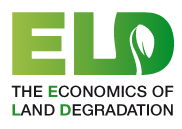A case study undertaken by the Economics of Land Degradation (ELD) Initiative in Ethiopia developed a detailed spatial assessment of the extent of land degradation, as well as the costs and benefits of different sustainable land management (SLM) options.
Covering roughly half of the country's total land area, which equates to most of Ethiopia's rainfed cropland areas, the study aimed to contribute to ELD's goal of providing tools for the total economic valuation of land degradation and SLM.
 May 2015: A case study undertaken by the Economics of Land Degradation (ELD) Initiative in Ethiopia developed a detailed spatial assessment of the extent of land degradation, as well as the costs and benefits of different sustainable land management (SLM) options. Covering roughly half of the country’s total land area, which equates to most of Ethiopia’s rainfed cropland areas, the study aimed to contribute to ELD’s goal of providing tools for the total economic valuation of land degradation and SLM.
May 2015: A case study undertaken by the Economics of Land Degradation (ELD) Initiative in Ethiopia developed a detailed spatial assessment of the extent of land degradation, as well as the costs and benefits of different sustainable land management (SLM) options. Covering roughly half of the country’s total land area, which equates to most of Ethiopia’s rainfed cropland areas, the study aimed to contribute to ELD’s goal of providing tools for the total economic valuation of land degradation and SLM.
The specific objective of the study was to find out how best to reduce both on-site and off-site impacts of soil degradation to achieve better cropland productivity and sustainability, as well as lessen sediment yields in river basins in order to ensure sustainability of reservoirs for hydropower generation and other purposes such as water supply and small-scale irrigation.
By adapting existing mapping methods – which involved combining visual delimitation of units of analysis (pixel based landscape information) with expert knowledge and automated image classification – the study team was able to better distinguish cultivated land from other land use or land cover classes. The team also mapped large-scale land use systems, inclusive of any foreign direct investments. As a result of the new mapping approach, the study found that the area covered by cultivated land is considerably larger than that indicated by official statistics in use since the mid-1980s, when the rural population was half its current size.
The study team analyzed eight land management scenarios for each specific location for the next 30 years, based on calculations of the net present values (NPV) of improved SLM technologies. The study concluded that farmers’ productivity can be maintained or slightly increased by applying SLM practices that involve a combination of soil and water conservation measures with fertilizer application and planting fodder grass on soil conservation structures, whereas crop production decreases if none are applied. The study estimated that a total of 44 billion Ethiopian Birr (about US$2 billion) is required to conserve the remaining sloping cultivated lands, involving a combination of direct investment and contributions that can be done by farmers themselves.
The study also developed a pixel-based database that can be used to perform cost-benefit analyses of different management options in the future.
The ELD case study was commissioned by the German Agency for International Development (GIZ), and carried out by the Centre for Development and Environment and the Water and Land Resource Centre in 2014. [Publication: Soil Degradation and Sustainable Land Management in the Rainfed Agricultural Areas of Ethiopia: An Assessment of the Economic Implications] [ELD Website]